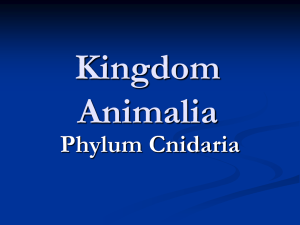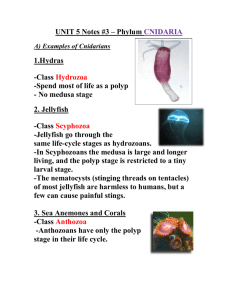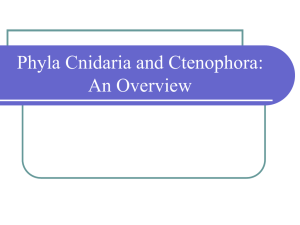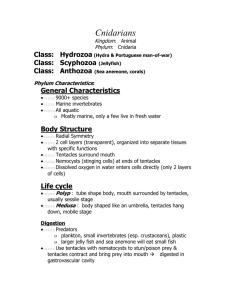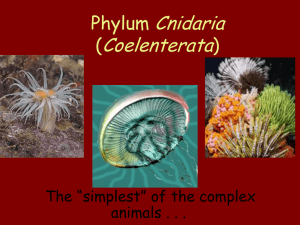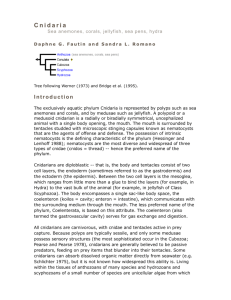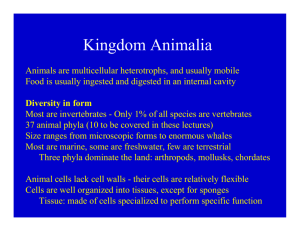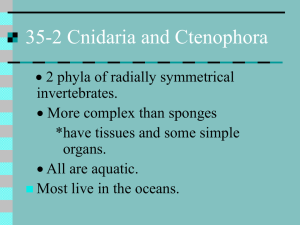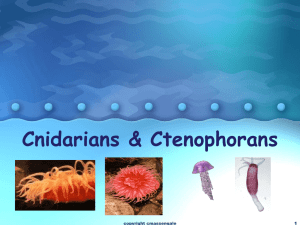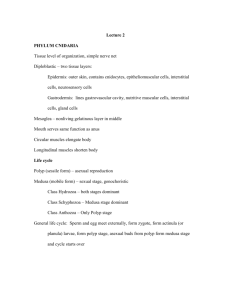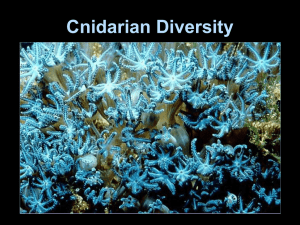Cnidaria and Ctenophora: External anatomy and survey of living
advertisement
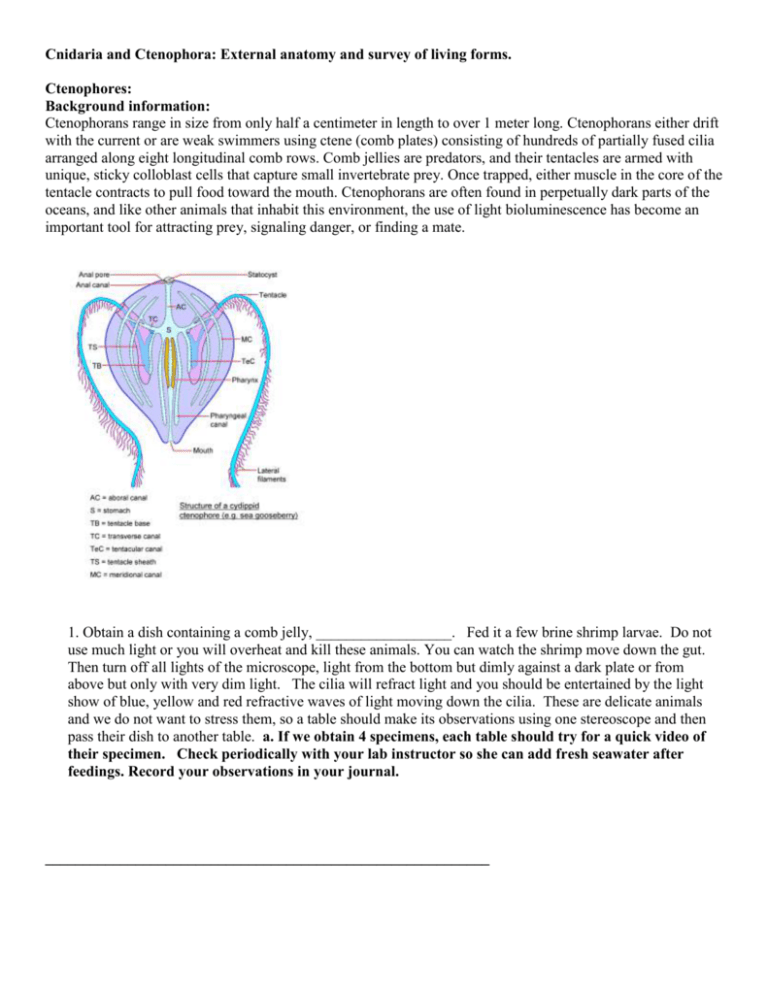
Cnidaria and Ctenophora: External anatomy and survey of living forms. Ctenophores: Background information: Ctenophorans range in size from only half a centimeter in length to over 1 meter long. Ctenophorans either drift with the current or are weak swimmers using ctene (comb plates) consisting of hundreds of partially fused cilia arranged along eight longitudinal comb rows. Comb jellies are predators, and their tentacles are armed with unique, sticky colloblast cells that capture small invertebrate prey. Once trapped, either muscle in the core of the tentacle contracts to pull food toward the mouth. Ctenophorans are often found in perpetually dark parts of the oceans, and like other animals that inhabit this environment, the use of light bioluminescence has become an important tool for attracting prey, signaling danger, or finding a mate. 1. Obtain a dish containing a comb jelly, __________________. Fed it a few brine shrimp larvae. Do not use much light or you will overheat and kill these animals. You can watch the shrimp move down the gut. Then turn off all lights of the microscope, light from the bottom but dimly against a dark plate or from above but only with very dim light. The cilia will refract light and you should be entertained by the light show of blue, yellow and red refractive waves of light moving down the cilia. These are delicate animals and we do not want to stress them, so a table should make its observations using one stereoscope and then pass their dish to another table. a. If we obtain 4 specimens, each table should try for a quick video of their specimen. Check periodically with your lab instructor so she can add fresh seawater after feedings. Record your observations in your journal. ___________________________________________________________ Cnidaria: External anatomy of various hydrozoans and scyphozoans. Background Information: The cnidarian body consists of a central blind sac, the coelenteron (= gastrovascular cavity), enclosed by a body wall comprising two epithelia, the outer epidermis and the inner gastrodermis. In some classes the term coelenteron is typically used and in others researchers use the term gastrovascular cavity. A gelatinous connective tissue layer, the mesoglea, lies between the two epithelia. The mouth opens at one end of the coelenteron and marks the oral end. The mouth is at the tip of a process, the manubrium that elevates it above the oral surface. The opposite pole is the aboral end. The imaginary line connecting the oral and aboral poles is the axis of symmetry around which the radial symmetry of the body is organized. The mouth is usually surrounded by one or more circles of tentacles. The defining cnidarian feature is, of course, their possession of stinging cells, or cnidocytes . Characteristic of the epidermis, they are also sometimes found in the gastrodermis. Cnidocytes contain an explosive organelle, the cnida, which, upon proper stimulation, inverts and ejects a slender, often barbed and toxic thread in the direction of prey or predator Three overall types of cnidae are found in cnidarians. Nematocysts (in nematocytes), spirocysts (in spirocytes), and ptychocysts (in ptychocytes). All toxic cnidae are nematocysts whereas spirocysts are sticky, and the everted tubules of ptychocysts are used for constructing feltlike tubes. Most cnidae are nematocysts and these are present in all three higher cnidarian taxa. Spirocysts and ptychocysts are found only in Anthozoa. The basic body plan described above can be manifest as a swimming medusa or attached polyp. In some taxa only one generation is present whereas in others both are found. A life cycle featuring alternation of sexual, swimming medusae with benthic asexual polyps is typical of many cnidarians. All cnidarians are carnivores feeding on live prey which they usually capture using tentacles armed with cnidocytes. Digestion occurs in the coelenteron which is typically equipped with ciliated canals for distribution of partly digested food. Diffusion across the body and tentacle surface eliminates the ammonia from the body. Gas exchange is across the general body surface.. Most cnidarians are gonochoric (sexes are separate). The life cycle typically includes a planula larva. Cnidarians are chiefly marine but the well-known Hydra is an exception. Classification of Cnidaria: Contains 3 or 4 clades or classes Class Hydrozoa: Hydroids. Usually both polyp and medusa. Class Scyphozoa: Jellyfish. Medusa dominant, polyp reduced Class Cubozoa: Some authors consider the Cubozoa ("sea wasps" and "box jellies" ) to be an order, the Cubomedusae, of the Scyphozoa. Medusa dominants. Box like construction to medusa. Class Anthozoa: Anemones and corals. Polyp only Most of the specimens you will be examining will belong to the class Hydrozoa or Anthozoa. It is almost impossible to keep adult Scyphozoans for more than 24 hours in the laboratory, although at times we will be fortunate enough to obtain polyps that may even produce ephyras or baby jelly fish for us. I will not have Cubozoan specimens because of tendency to deliver painful sometime fatal stings. We will be visiting websites for examination of other specimens of other classes or use slides an preserved specimens. 2. Your second exercise will be a look at variation among the class Hydrozoa. In all specimens examined, you should determine (if only from the web) what life stages to expect and whether the colonies exhibit polymophism. Everyone need to examine as one of their colonies, Hydractinia echinata if it is available. This is because of the high degree of polymorphism in this species. a. In all cases, record the other invertebrates present and living on the colony. b. Take a picture of two- three of the colonies available showing the different types of polyps present. In your journal compare and contrast the different types of polyps found. c. Film feeding in one of the colonies available. d. Identify all life stages that can be observed and determine from web search or the background information provided the number of different life stages exhibited by each species examined. Specimens that may be available Obelia This year one of the Hydozoan colonies that you may get to examine is Obelia. Obelia forms a long white branching colony more than ten centimeters long. The polyps of Obelia are housed in transparent cups for protection. When touched or exposed to the microscope's light the tentacles will withdraw into the cups. This species is the only one in the laboratory that will produce obvious medusae, which are released from the gonozooids, producing free-swimming male and female medusae velum with gonads, a mouth, and tentacles. The physical appearance of the male and female medusae velum, including their gonads, are indistinguishable, and the sex can only be determined by observing the inside of the gonads, which will either contain sperm or eggs. The medusae reproduce sexually, releasing sperm and eggs that fertilize to form a zygote, which later morphs into a blastula, then a ciliated swimming larva called a planula. Pennaria tiarella In Pennaria tiarella, medusa buds develop and are retained along sides of hydranths. Be careful, use gloves, Pennaria medusae as all medusae sting. Generally colonies are male or female, although the medusae of both sexes look alike and are difficult to distinguish. Eudendrium carneum Eudendrium carneum is a colonial form, which sports feeding individuals, and male or female gonophores. All Eudendrium species have lost the medusa and reproduce via gonophores. Sperm is produced by male gonophores and swims to fertilize eggs in female gonophores. Developing eggs are covered with polyp material or perisac and over time move down the polyp body . Clava sps. The polyps have 30 to 40 tentacles and have reproductive bodies clustered on short branches below the tentacles. The polyps are pink, white or red. In most species larvae develop from fertilized eggs and once settled give rise to new colonies. Tubularia sp. These are exceptional beautiful hydroids. There are many unbranched stems in a colony, each one ending in a feeding polyp (hydranth) with two groups of tentacles: short oral tentacles around the mouth and long aboral tentacles arranged about the base of the polyp. Reproductive structures (gonophores) hang in clusters between the two sets of tentacles with developing eggs and larvae clearly visible. The colour of the stems and tentacles is usually a pale-green to white but the rest of polyp may be hues of orange, pink or even bright red. Hydractinia echinata Obtain a hermit crab or at least a shell containing a colony of Hydractinia echinata. Identify if you can at least four types of individuals. Draw the different individuals you see. Graph the colony indicating the position of the various individuals to each other. Do not attempt in this drawing to show each individual but do indicate relative numbers and overall pattern. Watch carefully for epifauna. Various tubed annelids often live among the hydroids. Although considered a plus for the annelids that are protected, this relationship may be a minus for the hydroid colony as I have seen the worms steal food from the hydroids. Also look for other hydroids that may be competing with Hydractinia echina for space. Colonies that have to share their shell with these competitors may have different numbers of different individual or place their individuals in different positions relative to the intruding species. If you had to design a colony where would you place reproductives relative to defense individuals? Would the placements vary dependent on whether competitors were present or absent? Construct hypotheses regarding different conditions and then see if the distribution supports your hypotheses. Each pair should collect data on one shell. Exercise 3: A limited look at a Scyphozoan. Aurelia sp. Aurelia is a genus of Scyphozoa. oon Jellies begin life as a planula larva that settles and becomes a polyp that attaches itself onto a rock. A polyp can remain dormant for many years until it strobilates and produces many ephyrae. Each ephyra grows into the familiar bell-shaped adult jellyfish called a medusa. We may have a poly or strobila for you to observe. Next week you will have slides of both hydrozoan and scyphozoan life cycle stages to compare. NEXT WEEK: Internal anatomy of the cnidarians and poriferans. observations of poriferan preserved or slide material. Leave room in your journal to record
